Brook Hollow Golf Club, TX
by Eric Dorsey
Powerful socialite Cameron Buxton sought to create the best golf club in Dallas “ it was 1918. Buxton was a very accomplished amateur player winning major amateur events in the Philly area in the years before moving to Dallas. Buxton had some powerful friends in the golf circles that knew great golf “ AW Tillinghast and George Crump, who need no introduction. Buxton called on his close friend Tillinghast to find the best site for a golf course in the Dallas-Ft. Worth area. Back in this day, Dallas and Fort Worth were many, many miles apart; unlike now. Going out west of town, into the rural areas, Buxton and Tillinghast settled on a piece of land next to one of the myriad of branches to the Trinity River, which came down through the 2 cities. Ironically enough, this same setting along the Trinity River only 30 miles farther west, would ultimately become Marvin Leonard’s choice for his plot and dream course “ the famed Colonial CC.

Texas is known for it’s very inconsistent and mostly poor soil, consisting of mostly clay. Tillinghast’s keen eye must have been evident in selecting the site for Brook Hollow. Not only did the site consist of some unusual topography for the mostly flat DFW area; it was mostly sand, creating a wonderful base for the future turf that would drain quite well.
Ben Hogan loved Brook Hollow. And specifically #7, a 450-yard slightly uphill monster that swings sternly to the right with 3 gaping fairway bunkers on the inside. With Hogan’s patented fade, it was no wonder he called it “the best #7 hole in America.” Hogan was very methodical. He would break up his rounds of golf in sets of 3’s. 1-3, 4-6, 7-9, 10-12, 13-15, and 16-18. He remembered holes by their # alone, and recalling the best #13 hole for example would be easy for him as that’s the way he catalogued courses.
Shot-makers appreciate Brook Hollow, such as Hogan. Brook Hollow has only 2 straight holes, the gentle first and the long par-4, #12. After that 7 holes call for a fade off the tee, and 6 call for a draw, not considering the par-3’s.
Brook Hollow was built in the early 1920’s, before anything but farmland was around. Now, unfortunately, the club is in the middle of one of the worst neighborhoods in Dallas. Brick walls around the club and a very in-auspicious entry make the place almost invisible to the untrained eye. Driving through the gates to Brook Hollow GC is like stepping through a doorway to an oasis. Towering live oaks dominate the entry to a single story, modest, yet very southerly-elegant sprawling Ranch-style clubhouse.
On to the show! (yardages are from the tips)
Brook Hollow GC – Par 71
6,703 yards “ back (137 slope)
6,250 yards “ middle (128 slope)
#1, par 5, 483 yards: The first hole is the easiest hole on the course, going with the traditional gentle start. A slightly uphill par-5 that is straightaway, this hole also features some of the best bunkering on the course right off the bat. Many fairway traps alternating down the fairway to catch your ball and ruin your score, remind me of a hole from say, Kingston Heath with it’s irregularly shaped and placed traps. A traditional back-to-front sloping green framed by a beautiful, bright-white sycamore tree “ the only specimen on the course completes this hole.
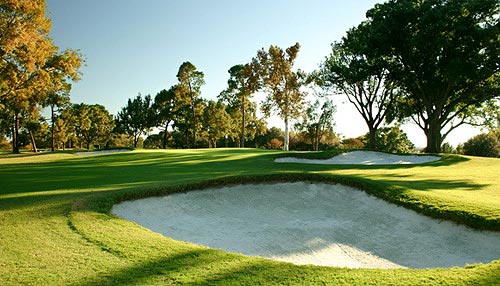
#2, par 4, 368 yards:The second moves slightly downhill and to the left, calling for a draw around a large oak at the corner or tempting the big hitter to take his drive up and over leaving a flip-wedge. A longish iron works perfect on this hole also leaving a short iron to a well guarded green that slopes sharply from back to front.
#3, par 4, 399 yards:The thirdalso moves to the left calling for another draw off the tee. A little longer than #2, the third is tighter and has little room for error on your tee shot. A 3-wood will leave you short of the fairway trap in the distance as this hole rises ever so slightly and then swings downhill to the left with the green sitting down in a hollow. This green, to me, is the most difficult on the course. It has a spine, or hogsback running the length of the green from say 7 o’clock to 2 o’clock. Any approach short of it will fall back and off the side, leaving a most dreaded chip up and over the ridge to pins that are usually on the downside of it. Chips hit too hard from here, and out of the dangerous Bermuda rough, will fall into a deep greenside trap and the strokes just pile up like this at Brook Hollow! On this hole, it’s so important to get a good drive out there so you can place your approach on the right side of this ridge.
#4, par 3, 152 yards:Thefourthlooks fairly benign from the tee, but has many hidden dangers. First of all, the shot plays usually 7-10 yards farther as it’s quite uphill “ some 15′ possibly. Secondly, the green has a nasty Ëœfalse-front’ on it, which is very severe. Up front pin locations are common here and make this hole a hard par. Deep traps guard both sides and the back right of the green, which slopes steeply from back-to-front.
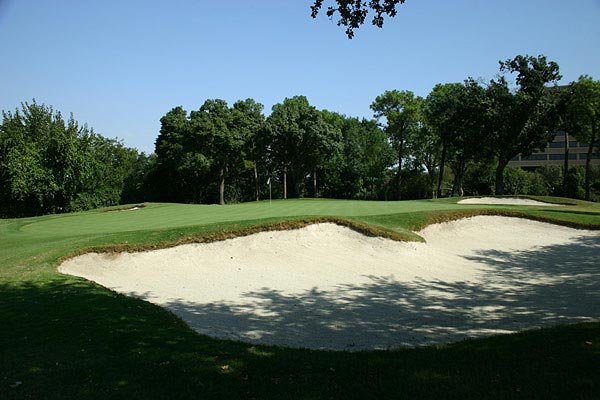
#5, par 4, 578 yards:The fifthis a long par 5 that swings to the right. Reachable by only the very biggest of hitters, #5 tempts you with taking your drive over the corner and the tall live-oaks and pecans, who usually win out. A large fairway trap on the left side and narrowing trees squeeze the lay-up area in. The green here slopes sternly again from back-to-front and has a rear-right wing with tough pin locations over fronting bunkers.
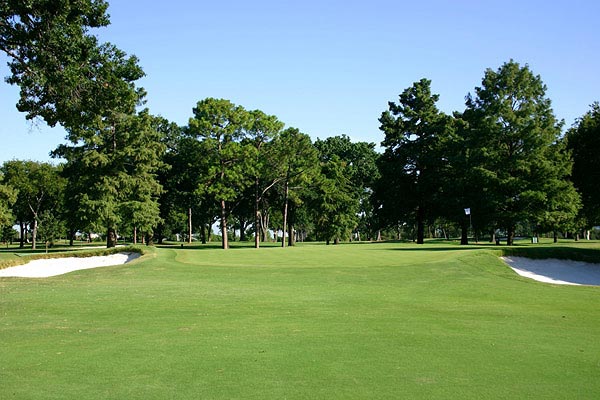
#6, par 4, 427 yards: The sixth is a beautiful and tough par 4. With a tee box tucked backed into a chute of trees, the drive must carry 2 huge fairway traps on the right or one must fade it around them to keep it in the fairway. The hole then swings sharply downhill with the green elevated up on the other side of a deep swale. This swale, which runs in front of #6, #9, #10, and #18, was once full of water and must of created heart-wrenching approaches. Recovery from the greenside traps or off the green here is next to zero as the tilt on the green and awkward lies can be brutal with Brook Hollow’s blazing greens.
#7, par 4, 449 yards:Sevenwas Ben Hogan’s favorite #7 hole in America. Slightly uphill, with a big swing to the right and huge fairway traps, this hole is an extremely difficult par. Heavily bunkered around the green also, #7 is framed by magnificent pines which Brook Hollow has quite a few of “ rare for Dallas.
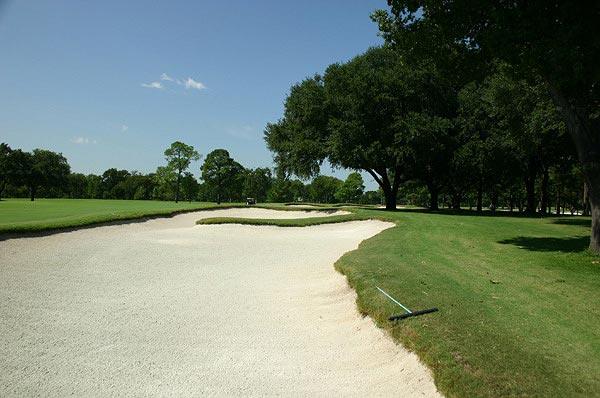
#8, par 3, 186 yards:The eighthplays some 30 feet downhill from the tips to a green set over a wide creek that wraps around the immediate right-side and front. This green, framed nicely with old specimen trees, has a large greenside trap on the left and probably the most tilted, back-to-front green on the course. Staying below this hole is a must. Being pin high and 30 or 40′ away, will give you an absolute impossible putt with some 10′ feet or more of break!
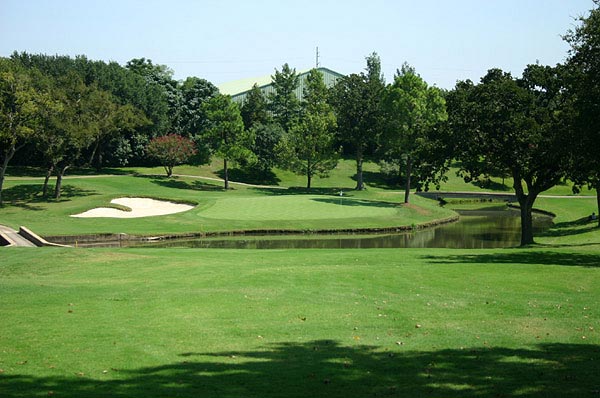
#9, par 4, 378 yards:Nine plays out of a chute of trees and is a sharp dogleg to the left. Tee shots taken over the corner are possible, but have to have a high trajectory to clear a tall oak. The approach here swings downhill and over the deep swale that fronts #6 to the green which is highly elevated (some 20′) and framed by massive trees on both sides “ a beautiful approach and one of my favorites on the course.
#10, par 3, 167 yards: The tenth, I feel is the signature hole on the course. It’s right outside the dining room windows and is the first hole you see once you walk around back of the clubhouse for your friendly game. Tillinghast’s (or Crenshaw’s J) touch is evident right away “ a beautiful par 3 over the same deep swale to a green that is perched up slightly with free-flowing, finger-like, deep traps guarding it’s every side. Enough said “ see pics. The wind swirls here and is usually one of the hardest holes on the course.
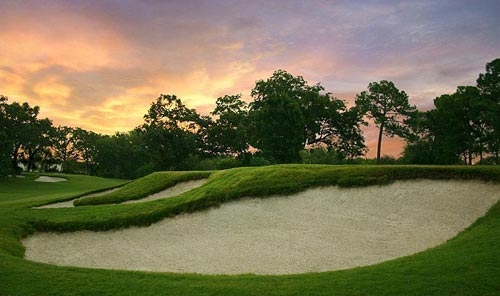
#11, par 4, 446 yards:Eleven is a slight dogleg left, and plays longer than it’s yardage “ making it a brutally hard par-4. Heavily trapped, this hole is part of Brook Hollow’s ËœAmen Corner’ I feel. #10, #11, and #12 are 3 of the hardest holes on the course and right in a row!
#12, par 4, 440 yards:Twelve continues the reasoning why Brook Hollow is such a classic and demanding test of golf. With no let-up yet, this long and straight, brutish par-4, travels over a gentle hill, then swings then slightly downhill with fronting greenside traps to a uncommonly flat green with a gentle back-to-front tilt.
#13, par 4, 363 yards:Thirteen provides some relief finally as this hole is the 3rd part of the #2-#3-#13 tri-fecta. These holes are like sisters to me “ they are about the same length, move the same way, and are right next to each other “ very unique! A long iron, 3W, or driver can be used here depending how confident you are with drawing the ball. Again, a straight tee ball will work, but will leave you 20 to 40 yards longer into your approach to a green set down into a hollow.
#14, par 4, 348 yards:The fourteenth, my personal favorite, is a beautiful par 4 that swings to the right and uphill. A gentle drive, or 3 wood can be placed straight away for a 7 or 8 iron into the green or the long hitter can take it over the corner with some tall pines and 2 menacing fairway traps waiting. Clearing all this means a 40 yd flip wedge; catching the tree or the traps means instant bogey or double. The green here, as is with most short par-4’s is jealously guarded with deep and beautiful traps almost all the way around and has a sharp back-to-front tilt to it. Wonderful old pines frame the green here as well.
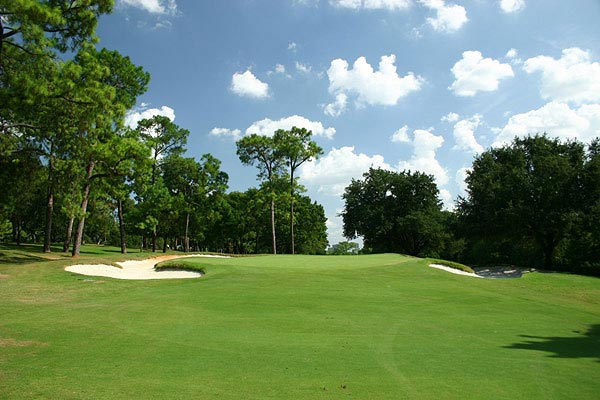
#15, par 5, 519 yards:Fifteen a slight gauntlet some 250 yards out makes you want to fade your ball to avoid trouble here “ ala Colonial’s #15 ironically enough. Reachable by the longer hitters, this hole falls off steeply on the right and has deep greenside traps that flash up some 10-12′ on the right side. The green here is again tilted from back-to-front and a lot from left to right also, making it very hard to read. One of the few birdie chances on the course.
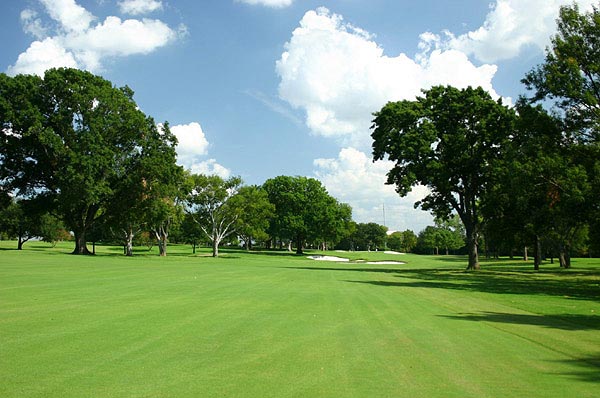
#16, par 3, 220 yards:Sixteen is simply a brutal par 3. It plays some 20′ uphill and 20 yards longer than it reads on the card. Sometimes refered to as one of Tillie’s ËœReef’ holes, this hole has a menacing fall-off on the right with another yawning and deep greenside trap. Shots straying right will bounce hard off our Ëœcement-like’ summer turf and possibly bounce OB, which is only some 15 yards beyond the green here. Par here with the pin in back takes a shot of almost 250 yards to a fairly narrow and sharply tilting green “ ouch!
#17, par 4, 385 yards: One of my favorites,the seventeenthis a beautiful example of Tillinghast’s wonderful bunkering. 3 diagonal bunkers starting at 220 yards out and just right of middle of fwy, to 280 yards out and to the right rough make this dogleg right a real driving test. Getting your ball into the fairway here leaves you with a flattish approach to an elevated, well guarded green. Another beautiful green complex framed with large pines and oaks, this green has a sharp fall-off the back and is fairly flat, leaving you with a make-able birdie putt if reached in 2.
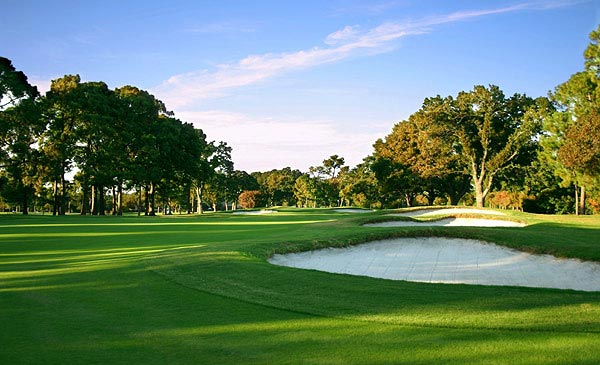
#18, par 415 yards: #18 is a drive out a tree-lined chute of trees to a fairway that falls off blindly and swings to the left with the green perched over the now familiar swale. A strong drive taken straight-away will appear to be fine as it skirts the large fairway trap on the right only to see that the ball rolled OB as the line is closer than appeared back on the tee. Thick trees guard the left side of this hole and even punching out is hard. The approach is a beautiful one to this somewhat benign green that has a wonderful canopy of towering live oaks and pecans. Backgrounds of unpleasant surrounds are the only downfall of this nice closer, but are being rectified this winter, as landscaping is being put-up to block out the views.
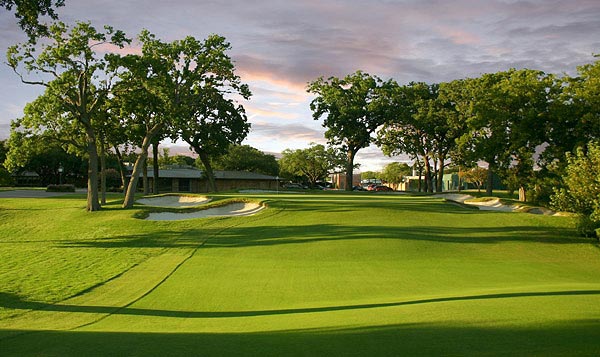
Brook Hollow is what is today because of one man really “ Ken Small, Director of Grounds. Small, who honed his skills at famed Southern Hills has the course in absolutely spectacular condition year around for the members. Given the brutal summers in Dallas, keeping lightning fast and perfectly conditioned A-4 bent greens is a challenge very few can pull off. And conditions in the dormant winter months can be, and many times are, better than many public courses in the spring and fall!
There is clearly no doubt for my love of classic courses. Brook Hollow to me is the best course in Texas. It’s 6700 yards that is full of pure shot-making examinations. The Texas Golf Association recently had it’s Mid-Am at Brook Hollow this past fall, one of it’s flagship events. 3 rounds with the usual blustery conditions faced here in Dallas, lightning fast, but none-the-less very receptive greens, yielded only a 213 (E) for the winner “ even par! And looking upon the large leaderboard, I saw many players reaching the high 80’s and even a few in the low 90’s. These were some of the best amateurs in region! Players and the lucky few visitors that even bothered coming out quickly learned that Brook Hollow’s short course is “All you’ll want!”
Brook Hollow GC remains voluntarily out of the public eye and is staunchly private, allowing no reciprocity whatsoever. Still, a round at Brook Hollow, if one comes your way is not to be missed. You will be treated to some of the best golf in the great state of Texas. The clubhouse, enjoying a recent $15 million renovation, is wonderfully charming and elegant, with some of the very best food in the highly competitive Dallas area being put out by master chef Dave Sokol. Donnie Ray’s seafood gumbo in the 19th hole is a real treat in the dark and foreboding room that is bathed in deep, leathered chairs and large HDTV’s. This room just drips with history! The men’s locker room is not far behind either with its wonderful cherry lockers and marble spa.
The End







